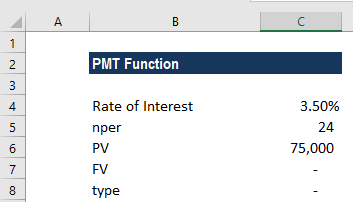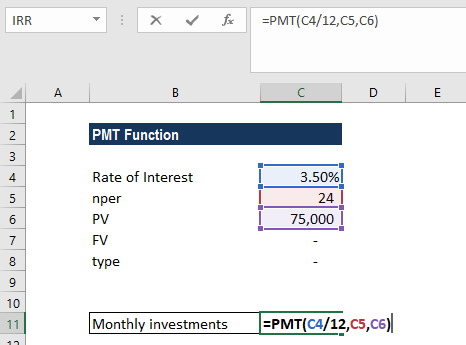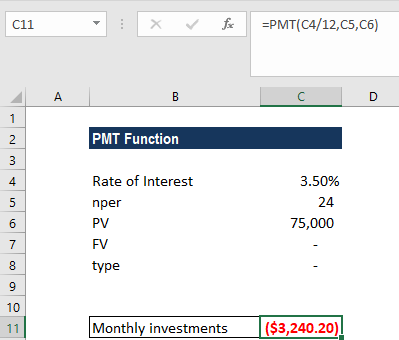Last updated on June 22nd, 2024 at 04:55 pm
PMT Full form in excel stands for payment. A very useful tool to calculate, equated payments either in investments or financing scenarios. In this article, you will get the full understanding of how to use it flawlessly.
Understanding PMT Function in Excel: PMT Full Form and Practical Applications
The PMT function in Excel, abbreviated from “Payment,” is a powerful tool for calculating equated payments in both investment and financing scenarios. This function plays a crucial role in financial planning by determining the periodic payment required to settle a loan or achieve a savings goal over a specified time frame. Whether you’re planning investments, managing loans, or forecasting retirement savings, mastering the PMT function can significantly streamline your financial calculations.
PMT Full Form In Excel
The PMT Full form in excel is Payment function and is categorised under financial Excel functions. This function helps in calculating the total payment required to settle a loan or an investment with a fixed interest rate over a specific time period. It can be used as a worksheet function (WS) and a VBA function in Excel. The PMT function can be entered as a part of the formula in a cell of a worksheet.
How does the PMT function Excel work?
PMT Excel Syntax:
PMT ( rate, nper, pv, [fv], [type] )
- Parameters:
- Rate – The interest rate for the loan
- Nper – The number of payments for the loan
- PV – The present value or principal of the loan
- FV – It is the future value of the loan amount outstanding after all payments have been made. If this parameter is omitted, it assumes an FV value of 0
- Type – It indicates when the payments are due. If this parameter is omitted, it assumes a Type value of zero. If the Type value is, one, payments are due at the beginning of the period, and if the Type value is zero, the payments are due at the end of the period.
- Returns:
The PMT function returns a numeric value
- Applies to:
Excel for Office 365, Excel 2019, Excel 2016, Excel 2013, Excel 2011 for Mac, Excel 2010, Excel 2007, Excel 2003, Excel XP, Excel 2000
PMT Full Form in Excel
The PMT function in Excel, categorized under financial functions, simplifies complex calculations by considering key parameters such as interest rate, number of payments, present value (loan amount or investment principal), future value, and payment type (beginning or end of the period). This function is versatile and can be utilized within Excel worksheets or incorporated into Visual Basic for Applications (VBA) to automate financial modeling and analysis processes.
In practical terms, understanding how to use the PMT function empowers users to accurately compute various financial scenarios. For instance, calculating monthly loan repayments, determining required savings contributions for retirement, or assessing lease payment obligations becomes straightforward and efficient. By leveraging PMT, individuals and businesses alike can make informed financial decisions with confidence, ensuring optimal management of resources and goals attainment.
Example: SIP using PMT Formula in Excel
Let’s assume that we need to invest in such a manner that, after two years, we’ll receive $75,000. The rate of interest is 3.5% per year and the payment will be made at the start of each month. The time period is entered in months so 2 years are 2*12=24 months. The details are:

The formula used is:

We get the results below:

Using PMT for Loan Cases
Now, let’s look at how we can use the PMT function in excel, to calculate EMIs on loans. So, first understand that a loan let’s say INR 50,00,000/-, with an interest rate of 9% per annum and a loan tenure of 20 years.
So, firstly always remember that, since we are calculating loans on a monthly basis, we need to convert the following to monthly rates.
- Rate of 9%, convert to monthly by dividing it by 12 months. i.e., 0.75%
- Period of 20 years also needs to be converted to 240 months.
Finally, let’s get this all together into the PMT function excel.

So, the EMI should be INR -44986 Per month.
Important Points to Remember
So, it’s crucial to remember some basic pointers about PMT function excel.
- PMT sign is the opposite of the PV sign. So if it’s an investment or EMI then PMT has to put in a negative sign.
- Also, PMT can only calculate values for equal cashflows only.
- PMT will throw an error if PV & FV are both positive.
Full form of PMT In Excel
Many times, students have the query that what exactly is the full form of PMT.Pmt actually stands for the simple word “ Payment”, signifying recurring payments over a period of time.
Examples for PMT Applications in Real Life
Loan Repayment Calculation
Suppose you want to calculate the monthly payment amount for a loan with a principal amount of $50,000, an annual interest rate of 5%, and a loan term of 5 years. To calculate the monthly payment, you can use the PMT function.
Formula: =PMT(5%/12, 5*12, -50000)
Answer: The monthly payment for this loan would be $943.36.
Explanation: The PMT function is used to calculate loan payments based on the interest rate, loan term, and principal amount. In this case, the interest rate is divided by 12 (number of months in a year) to get the monthly interest rate. The loan term is multiplied by 12 to convert it into the number of monthly payments. The principal amount is entered as a negative value since it represents a cash outflow.
Investment Savings Calculation
Let’s say you want to determine the monthly deposit required to accumulate $100,000 in savings over a period of 10 years with an annual interest rate of 4%. You can use the PMT function to calculate the required monthly deposit.
Formula: =PMT(4%/12, 10*12, 0, 100000)
Answer: The monthly deposit required to accumulate $100,000 in 10 years would be approximately $789.24.
Explanation: In this example, the PMT function calculates the monthly deposit necessary to accumulate a specific future value. The interest rate is divided by 12 to obtain the monthly interest rate. The loan term is multiplied by 12 to convert it into the number of monthly deposits. The future value is set to 0 because we want to accumulate a specific amount over time.
Mortgage Payment Calculation
Suppose you want to calculate the monthly mortgage payment for a house with a loan amount of $200,000, an annual interest rate of 4.5%, and a loan term of 30 years. The PMT function can be used to determine the monthly payment.
Formula: =PMT(4.5%/12, 30*12, -200000)
Answer: The monthly mortgage payment for this loan would be $1,013.37.
Explanation: In mortgage calculations, the PMT function is useful for determining the fixed monthly payments. The interest rate is divided by 12 to obtain the monthly interest rate, and the loan term is multiplied by 12 to convert it into the number of monthly payments. The principal amount is entered as a negative value since it represents a cash outflow.
Lease Payment Calculation
Let’s say you are leasing a car with a monthly lease rate of $300, and the lease term is 3 years. To calculate the present value of the lease payments, you can use the PMT function.\
Formula: =PMT(0%, 3*12, 300)
Answer: The present value of the lease payments would be $10,800.
Explanation: In this scenario, the interest rate is set to 0% since it is a lease. The lease term is multiplied by 12 to convert it into the number of monthly payments. The monthly lease rate remains unchanged as it represents the cash outflow.
Retirement Savings Calculation
Suppose you want to determine the monthly contribution needed to accumulate $500,000 in retirement savings over a period of 25 years with an expected annual return of 6%. You can use the PMT function to calculate the required monthly contribution.
Formula: =PMT(6%/12, 25*12, 0, -500000)
Answer: The monthly contribution required to accumulate $500,000 in 25 years would be approximately $1,377.98.
Explanation: In this example, the PMT function is used to calculate the monthly contribution needed to reach a specific future value. The expected annual return is divided by 12 to obtain the monthly interest rate. The loan term is multiplied by 12 to convert it into the number of monthly contributions. The future value is entered as a negative value since it represents the desired savings goal.
The PMT function in Excel is a versatile tool that enables users to perform various financial calculations quickly and accurately. By understanding how to apply it in different scenarios, you can streamline your financial analysis and decision-making processes.


